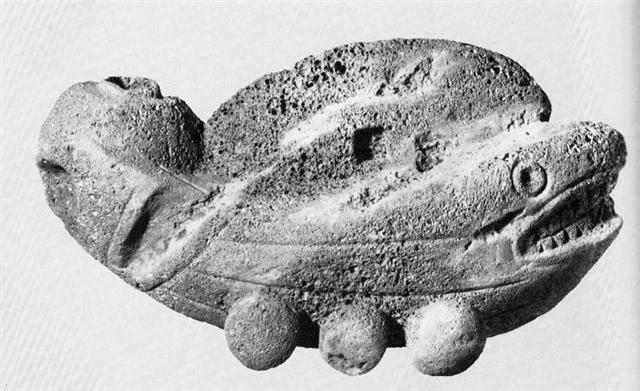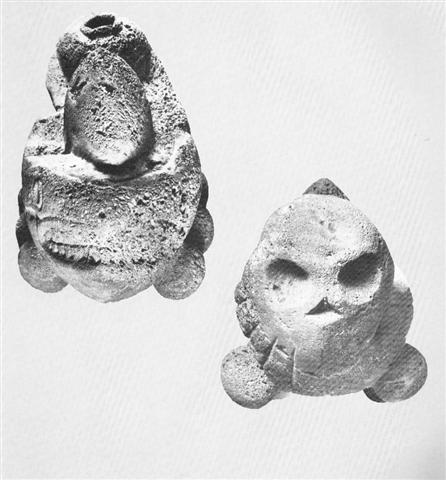5. One obvious constellation with the pattern 3 + 0 + 3 is Tauono (6 stones), and in the picture below we can even imagine the outline of 0 drawn like a rhomb:
North of the equator and closer to home the Pleiades were regarded as 7 stars. But with Saturn at the end of the week, where light is 'quenched by water' (Swedish Lördag means the day of taking a bath), 7 should be only theoretical. The visible main stars are only 6 in number: "Savage tribes knew the Pleiades familiarly, as well as did the people of ancient and modern civilization; and Ellis wrote of the natives of the Society and Tonga Islands, who called these stars Matarii, the Little Eyes: The two seasons of the year were divided by the Pleiades; the first, Matarii i nia, the Pleiades Above, commenced when, in the evening, those stars appeared on the horizon, and continued while, after sunset, they were above. The other season, Matarii i raro, the Pleiades Below, began when, at sunset, they ceased to be visible, and continued till, in the evening, they appeared again above the horizon. Gill gives a similar story from the Hervey group, where the Little Eyes are Matariki, and at one time but a single star, so bright that their god Tane in envy got hold of Aumea, our Aldebaran, and, accompanied by Mere, our Sirius, chased the offender, who took refuge in a stream. Mere, however, drained off the water, and Tane hurled Aumea at the fugitive, breaking him into the six pieces that we now see, whence the native name for the fragments, Tauono, the Six, quoted by Flammarion as Tau, both titles singularly like the Latin Taurus. They were the favorite one of the various avelas, or guides at sea in night voyages from one island to another; and, as opening the year, objects of worship down to 1857, when Christianity prevailed throughout these islands." (Allen) However, myth also tells about a pair of missing stars: "... Now the deluge was caused by the male waters from the sky meeting the female waters which issued forth from the ground. The holes in the sky by which the upper waters escaped were made by God when he removed stars out of the constellation of the Pleiades; and in order to stop this torrent of rain, God had afterwards to bung up the two holes with a couple of stars borrowed from the constellation of the Bear. That is why the Bear runs after the Pleiades to this day; she wants her children back, but she will never get them till after the Last Day." (Hamlet's Mill) In Hawaii, we have seen earlier, the beginning of the year was connected with the reappearance of the Pleiades in the evening and it is reasonable to believe such was the case on Easter Island too, although it was high summer. The reappearance in the early evening sky of 6 'redhot newborn children' from the 'earth oven' inaugurated a season with Tauono 'up above'. An earth oven (umu) should ideally have 5 stones, though, because a fire place ought to be connected with the 5 fingers on a hand (rima) - an idea ultimately, I guess, based on the pentagram described in the night sky by Venus (the planet ruling birth):
(From Erich Zehren: Stjärnornas testamente.) My suggestion of the proper form of an earth oven, however, is primarily based on an earth oven in pentagonal form depicted on a remarkable stone sculpture:
"The image is that of a reed boat with a whale's or sea monster's head at the bow, and a skull-like mask at the stern. At the top of the stern is a five-sided umu, or Easter Island fireplace, and on deck is a hare paenga, or lenticular reed house, with a square doorway on the starboard side. On the same side, a wide channel surrounded by a V-shaped groove leads down from the deck aft." The pictures and comments are from Thor Heyerdahl's The Art of Easter Island. I do not agree with his interpretation of the sculpture showing a reed boat. Instead the image is first of all probably a 'Sun fish'. The grin at front is a sure sign. But I can also refer to Leo Frobenius' Das Zeitalter des Sonnengottes, where he convincingly describes how all over the world the rising sun normally either is thought of as a fish (rising from the sea) or as a bird (rising into the air). But the hare paega carried on the back of the Sun fish, like a head gear, will secondarily transform him into a boat with right side up. And it is important to notice the 3 + 3 'balls' on which the Sun fish is moving. At his front end (spring) there are teeth for eating, at the tail end there is a death skull, and in between we can count to 3 + 3 = 6 rolling stones. The Sun fish himself has the central (0) position. |



